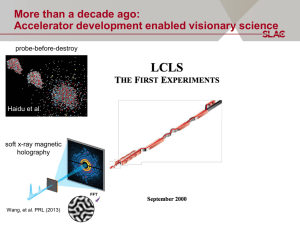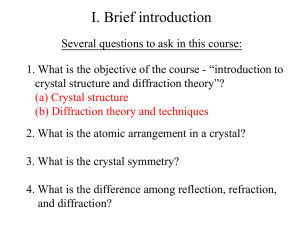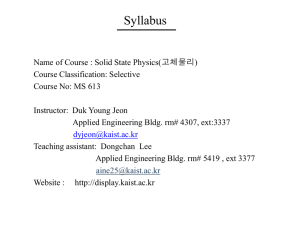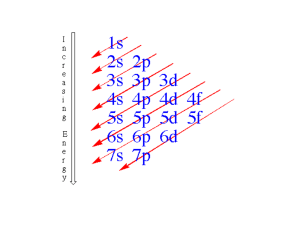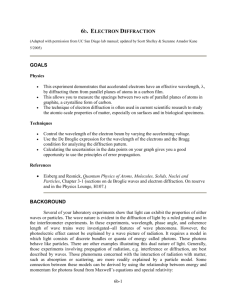exp6-R1
advertisement
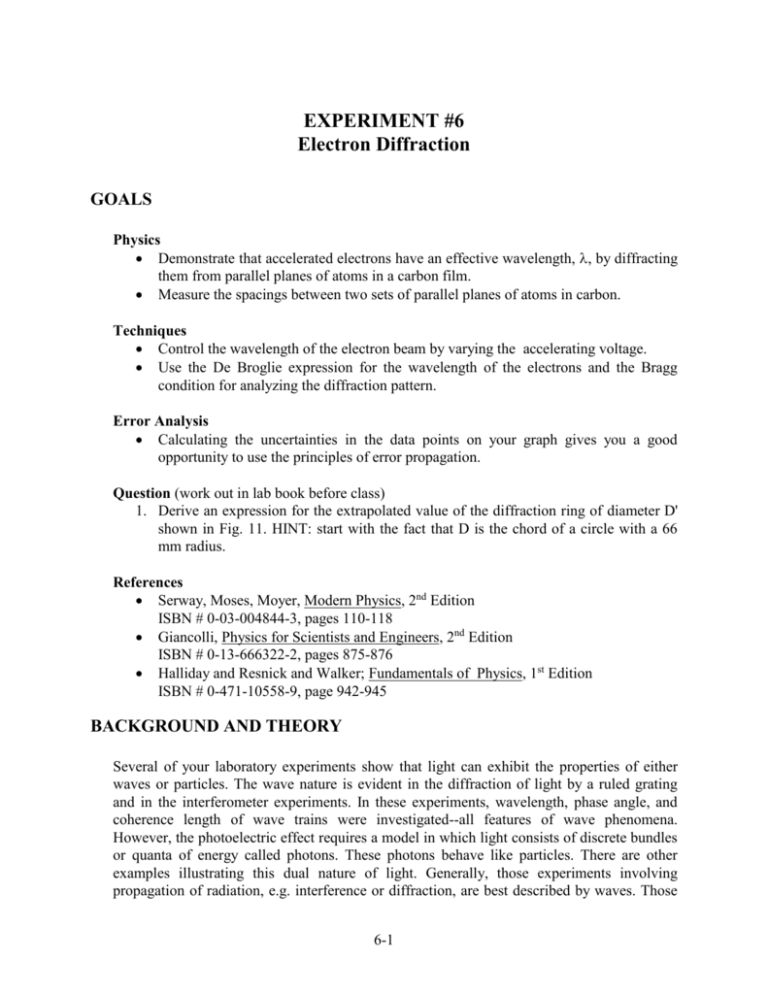
EXPERIMENT #6 Electron Diffraction GOALS Physics Demonstrate that accelerated electrons have an effective wavelength, , by diffracting them from parallel planes of atoms in a carbon film. Measure the spacings between two sets of parallel planes of atoms in carbon. Techniques Control the wavelength of the electron beam by varying the accelerating voltage. Use the De Broglie expression for the wavelength of the electrons and the Bragg condition for analyzing the diffraction pattern. Error Analysis Calculating the uncertainties in the data points on your graph gives you a good opportunity to use the principles of error propagation. Question (work out in lab book before class) 1. Derive an expression for the extrapolated value of the diffraction ring of diameter D' shown in Fig. 11. HINT: start with the fact that D is the chord of a circle with a 66 mm radius. References Serway, Moses, Moyer, Modern Physics, 2nd Edition ISBN # 0-03-004844-3, pages 110-118 Giancolli, Physics for Scientists and Engineers, 2nd Edition ISBN # 0-13-666322-2, pages 875-876 Halliday and Resnick and Walker; Fundamentals of Physics, 1st Edition ISBN # 0-471-10558-9, page 942-945 BACKGROUND AND THEORY Several of your laboratory experiments show that light can exhibit the properties of either waves or particles. The wave nature is evident in the diffraction of light by a ruled grating and in the interferometer experiments. In these experiments, wavelength, phase angle, and coherence length of wave trains were investigated--all features of wave phenomena. However, the photoelectric effect requires a model in which light consists of discrete bundles or quanta of energy called photons. These photons behave like particles. There are other examples illustrating this dual nature of light. Generally, those experiments involving propagation of radiation, e.g. interference or diffraction, are best described by waves. Those 6-1 phenomena concerned with the interaction of radiation with matter, such as absorption or scattering, are more readily explained by a particle model. Some connection between the wave and particle models can be derived by using the principal of the equivalence of mass and energy introduced by Einstein in 1905 in his special theory of relativity, namely, E= mc2 . In this equation E is the total energy of a body, m is its mass, and c is the velocity of light. From the photoelectric experiment we learned that light may be considered to consist of particles called photons whose energy is E = hf where f is the frequency of light and h is Planck's constant. We may equate these two energies and obtain: mc2 = hf, or mc = hf/c = h/ where is the wavelength of the light. Now mc is the momentum of a photon with equivalent mass m traveling with velocity c. Thus the momentum of radiation may be expressed either in terms of the wave characteristic or by the mass and velocity of the equivalent particle. This dual situation with respect to radiation led de Broglie in 1925 to suggest that a similar duality should exist for those entities which had previously been regarded as particles. Thus, a particle such as an electron with mass m, traveling with velocity v, has a momentum mv. De Broglie stated that this particle could also behave as a wave and its momentum should equal the wave momentum, i.e. mv = h/r h/mv . It was then a question of verifying this hypothesis experimentally. If an electron is accelerated through a potential difference V, it gains a kinetic energy 1 mv 2 eV , or 2 mv 2emV where e is the electron charge and m is its mass. Substituting this value for v in the de Broglie expression for the wavelength gives 6-2 h mv 1 / 2 h V 9 (1.23 10 m) 2meV 1 volt (1) Thus it should be fairly simple to produce a beam of electrons of a known wavelength by accelerating them in a voltage V. This beam could then be used in experiments designed to demonstrate wave properties, e.g. interference or diffraction. One might try to diffract the beam of electrons from a grating. However, the spacings between the rulings in man-made gratings are of the order of several hundred nm. From Equ. (1), we find that even with an accelerating voltage as low as 1. V, the electron wavelength is only 1.2 nm. As we will see shortly, such a large difference between the grating spacing and the electron wavelength would result in an immeasurably small diffraction angle. It was recognized, however, that the spacings between atoms in a crystal were of the order of a few tenths of a nm (1 Angstrom = 0.1 nm). Thus, it might be feasible to use the parallel rows of atoms in a crystal as the "diffraction grating" for an electron beam. This possibility seemed particularly promising since it had been found that x-rays could be diffracted by crystals, and x-ray wavelengths are similar to the wavelengths of 100 eV electrons. Figure 1 shows some of the possible arrangements of atoms in a cubic pattern. (a) is the simple cubic form. When an atom is placed in the center of the simple cube, we get (b), the body-centered-cubic form. Figure 1: Three cubic arrangements of atoms in a crystal. (a) simple cubic, (b) body centered-cubic, (c) face-centered cubic When atoms are placed on the faces of the cube, as in (c), the arrangement is called facecentered-cubic. For example, the atoms in nickel and sodium chloride are arranged in the face-centered-cubic pattern. In an iron crystal, the body-centered-cubic arrangement is found. Figure 2 shows a view of body-centered-cubic atoms looking perpendicular to one of the cubic faces. Three different orientations of parallel rows of atoms are distinguished with different spacings between the parallel rows. These parallel rows of atoms lie in parallel 6-3 atomic planes, and it is evident that there are a large number of families of parallel planes of atoms in a crystal. Figure 2: Interplanar spacings, d, of different families of parallel planes in a cubic array of atoms. Figure 3: Scattering of waves from a plane of atoms. Path difference for waves from adjacent atoms. We consider the scattering of waves from a single plane of atoms as shown in Fig. 3. The atoms are spaced a distance d' apart. The incident wave makes an angle with a row of atoms 6-4 in the surface. a c is the wave front. The scattered wave makes an angle with the surface; its wavefront is b e . Constructive interference will occur for the rays scattered from neighboring atoms if they are in phase -- if the difference in path length is a whole number of wavelengths. The difference in path length is a e c b . Therefore a e cb d' cos d' cos m , where m is an integer. Another condition is that rays scattered from successive planes separated by a distance d also meet in phase for constructive interference. Figure 4 shows the construction for determining this condition. Figure 4: Path difference for waves scattered from successive planes of atoms. The difference in path length for rays traveling from planes 1 and 2 is seen to be a b b c , the extra distance traveled by the ray scattered from plane 2. This path difference must again be an integral number of wavelengths. Therefore a b b c d sin d sin n These conditions can be satisfied simultaneously if = . In that case m = 0 satisfies the first condition and n 2dsin satisfies the second condition. This relation was developed by Bragg in 1912 to explain the diffraction of x-rays from crystals. The parameter n is called the “order” of the diffraction spectrum. 6-5 Thus the conditions for constructive interference are that the incident and scattered beams make equal angles and that the relation n 2dsin must be obeyed where d is the spacing between parallel adjacent planes of atoms. In 1927, Davisson and Germer at the Bell Telephone Laboratories investigated the scattering of a beam of electrons from a nickel crystal. Figure 5 shows, schematically, the essentials of their apparatus. Figure 5: Experimental arrangement for the Davisson-Germer electron diffraction experiment. Electrons from the heated filament F, were accelerated through a potential difference of order 100V to a plate P with a small diameter hole. A narrow beam of electrons emerged from the opening in P and was incident normally on the face of the nickel crystal C. The electrode E was connected to a sensitive galvanometer and measured the intensity of the electrons scattered by the nickel crystal at various angles . Some of the experimental results are shown in Fig. 6. These are “polar plots” of the beam intensity as a function of the angle for various accelerating voltages which correspond to the wavelengths indicated. In each plot, a line drawn from the origin to any point on the curve makes the angle ; the length of a line is proportional to the electron beam intensity at that angle . 6-6 Figure 6: Polar plot of Davisson and Germer's data for the scattered electron beam intensity as a function of scattering angle for different incident electron energies. As the voltage was increased from 44 to 88 volts, a characteristic peak gradually appears and then disappears. It reaches a maximum for electrons with an energy of 54 eV (.167nm) at an angle of 50o . Davisson and Germer concluded that this peak was due to Bragg reflection from a set of regularly spaced atomic planes within the crystal as shown in Fig. 7. Figure 7: Illustrating the Bragg condition for electron waves scattered from planes of atoms in the nickel crystal used by Davisson and Germer. The angle 2 is measured in the experiment. The diffracting planes must be normal to the bisector of , so planes is given by 2 . The angle of incidence between the beam and the scattering 6-7 90 o 90 o 2 The spacing between the planes involved in the diffraction is d. From x-ray measurements, the spacing D between the surface atoms was known to be 0.215nm. If the diffraction planes make an angle with the surface, then d = D sin . Therefore, the measured scattering angle of = 50o determines d as d = D sin = 0.215 sin (50o /2) = 0.215 sin (25o ) . The crystal is apparently oriented such that the angle of incidence is 90o - 50o/2 = 65o . The Bragg condition for the first order reinforcement then says the electron wavelength is 2dsin 20.215sin 25o sin65o .165nm. The electron wavelength calculated from the de Broglie relation using the known energy of the beam is h 0.167nm . mv This close agreement convinced Davisson and Germer that they had observed the diffraction of electron waves from the nickel crystal. In this experiment and in a number of subsequent ones, Davisson and Germer observed that while agreement was close between the observed and calculated diffraction data, there was usually a small discrepancy that was larger for the low energy (longer wavelength) electron beams. They were able to show that this discrepancy was due to the fact that the electrons were refracted as they entered the crystal. The index of refraction, , of a crystal was greater than 1, due to the fact that the electrons gained energy on entering the crystal. For those low energy beams where (E) differs significantly from 1, the Bragg relation is modified to n 2d( cos2 ) 2 1 2 Thus far, only single crystals have been considered. Most materials are polycrystalline. They are composed of a large number of small crystallites (single crystals) that are randomly oriented. An electron diffraction sample may be a polycrystalline thin film, thin enough so that the diffracted electrons can be transmitted through the film. The experimental arrangement shown in Fig. 8 was used by Thomson in 1927 to study the transmission of electrons through a thin film C. The transmitted electrons struck the 6-8 photographic plate P as shown. The pattern recorded on the film was a series of concentric rings. This pattern arises from the polycrystalline nature of the film. Figure 8: The experimental arrangement used by Thomson for his transmission electron diffraction research. Figure 9(a) shows a beam of electrons of wavelength traveling from the left and striking a plane of atoms in a crystallite. If this plane makes the angle with the incident beam such that = 2d sin , where d is the spacing of successive atomic planes, the beam will be diffracted by the angle = 2. Figure 9: Showing how the randomly oriented crystallites in a polycrystalline film scatter into a cone when the Bragg condition is fulfilled by planes of atoms disposed symmetrically about the incident beam. 6-9 Now there are many randomly oriented crystallites in this film. Thus we may expect that there will be crystallites in which this diffracting plane makes the same angle with the beam direction but rotated around the beam in a cone as shown in Fig. 9(b). The diffracted beams from this plane from all the crystallites in the sample will fall on a circle whose diameter may be determined from the cone angle and the distance from the sample to the film or other detector. The Bragg condition becomes n = 2d sin 2d= d . In 1927 the wave nature of electrons was verified by reflection and transmission diffraction experiments using these techniques. For this work Davisson and G.P. Thomson were awarded the Nobel prize in 1937. De Broglie received the Nobel prize in 1929 for his basic insight on the wave nature of matter. DAVISSON-GERMER EXPERIMENT Fig. 10 shows the arrangement of the atoms in a carbon crystal; the atoms are located on the corners of hexagons. The two principal spacings of the atom planes are indicated; these spacings are d1 = 0.123 nm and d2 = 0.213 nm . Figure 10: Atom arrangements in carbon showing the two sets of planes that produce the diffraction rings. As explained in the BACKGROUND AND THEORY text, the diffraction condition for the polycrystalline carbon film is as follows: 6-10 d . From this equation and from Fig. 9 we can determine the relationship between D’ and . In Fig. 9, the diffraction cone makes an angle of from the center line. The value for D' permits you to calculate 2 from the small angle approximation D . 2L Writing in terms of the anode voltage and using d gives (1.23 nm)Va 1 / 2 for the Bragg condition. Dd 2L Figure 11: Sketch of the geometry involved in determining the extrapolated ring diameter, D'. Use this diagram to determine the relationship between D and D’ in order to complete all necessary calculations. THIS EXPERIMENT PURPOSE By analyzing the diffraction pattern on the bulb of the Davisson-Germer apparatus, find the spacings between the atoms of polycrystalline carbon film. EQUIPMENT 1. Electron diffraction tube with carbon thin film target. 2. High and low voltage power supplies. 3. Digital voltmeter for monitoring anode current. 4. Calipers for measuring diffraction ring diameters. 6-11 EXPERIMENTAL SETUP Figure 12: The electron diffraction tube The electron diffraction tube is sketched in Fig. 12 and Fig. 13 is a picture of this apparatus. The carbon film is mounted in the anode as shown. The variable anode voltage Va is provided by the 5kV dc supply. Use the outer high voltage terminals. The electrons are emitted from an indirectly-heated oxide coated cathode. The heater voltage, VF, is supplied by the 6V output on the 5kV supply. VF is applied to the 4 mm diameter terminals in the plastic cap at the end of the tube. The external bias Vbias for the can surrounding the cathode is provided by the separate power supply. The negative biasing of the can surrounding the cathode serves to focus the electron beam. The beam current Ia varies with both anode and bias voltages. Be sure to keep the beam current below 0.2 mA as monitored on the DMV in the grounded side of the anode circuit. The 2 mm pin on the back of the tube is the terminal for the negative side of the anode voltage. The positive side of the anode voltage is connected to the 4 mm pin on the side of the tube. The diffraction rings are viewed on the phosphor screen on the glass bulb. 6-12 DMM Power Source/Voltmeter Electron Diffraction Tube Figure 13 CAUTION The 5kV power source can give you a very nasty shock. Verify that your circuit is correctly wired before turning on power. Have your instructor or TA check the circuit. Check that the anode current monitoring meter is on the grounded side of the circuit as shown in the diagram below. Never permit the anode current to exceed 0.2 mA; otherwise the target may be damaged. PROCEDURE 1. After having your circuit checked, start the experiment by stabilizing the heater current for about a minute before turning on the anode voltage. The external bias voltage Vbias helps to focus the diffraction rings as well as limiting the anode current to 0.2 mA. 2. As you turn up the anode voltage you will see two rings on the screen, as shown in Fig. 12. Each ring corresponds to one of the carbon d spacings (d1 or d2). 3. Measure the ring diameter D on the screen with the calipers. 4. Calculate the extrapolated ring diameter D', as shown in fig. 12. Take into account both the curvature and thickness of the glass bulb. 6-13 5. Calculate and from D' for each consecutive Va. 6. Graph Results: For each ring, plot Va-1/2 as a function of D' for a number of values of V. 7. Determine d1 and d2 from the slopes of these curves. Using error analysis, compare your values to the d spacings for carbon. TROUBLESHOOTING Darkening your work area will increase your ability to see the rings. Measure both horizontal and vertical diameter to ensure accuracy. The question at the beginning of this exercise may be solved two ways. Use similar triangles to deduce D' using either the appropriate trigonometric ratios or with the Pythagorean formula. 6-14


